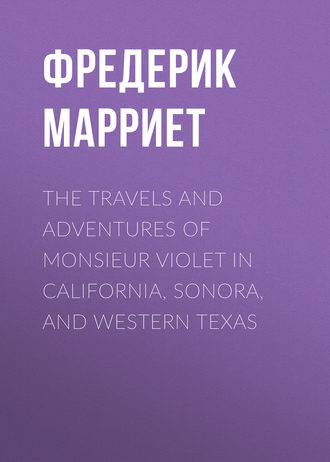 полная версия
полная версияThe Travels and Adventures of Monsieur Violet in California, Sonora, and Western Texas
Thus, link after link, Smith extends his influence, which is already felt in Illinois, in Iowa, in Missouri, at Washington, and at the very foot of the Rocky Mountains. Moreover, hundreds of Mormons, without avowing their creed, have gone to Texas, and established themselves there. They save all their crops, and have numerous cattle and droves of horses, undoubtedly to feed and sustain a Mormon army on any future invasion. Let us now examine further into this cunning and long-sighted policy, and we shall admire the great genius that presides over it. We are not one of those, so common in these days, who have adopted the nil admirari for their motto. Genius, well or ill guided, is still genius; and if we load with shame the former life of Smith and his present abominable religious impositions, still we are bound to do justice to that conquering spirit which can form such vast ideas, and work such a multitude to his will.
The population of Texas does not amount to seventy thousand souls, among whom there are twenty-five different forms of religion. Two-thirds of the inhabitants are scoundrels, who have there sought a refuge against the offended laws of their country. They are not only a curse and a check to civilization, but they reflect dishonour upon the remaining third portion of the Texans, who have come from distant climes for the honest purposes of trade and agriculture. This mongrel and mixed congregation of beings, though firmly united in one point (war with Mexico, and that in the expectation of a rich plunder), are continually at variance on other points. Three thousand Texans would fight against Mexico, but not two hundred against the Mormons; and that for many reasons: government alone, and not an individual, would be a gainer by a victory; in Texas, not a soul cares for anything but himself. Besides, the Mormons are Yankees, and can handle a rifle, setting aside their good drilling and excellent discipline. In number, they would also have the advantage; while I am now writing, they can muster five thousand well-drilled soldiers, and, in the event of an invasion of Texas, they could easily march ten thousand men from the Sabine to the Rio Grande, from the Red River to the Gulf of Mexico. Opposition they will not meet. A year after the capture, the whole of Texas becomes Mormon, while Joe–king, emperor, Pharaoh, judge or regenerator–rules over a host of two hundred and fifty thousand devoted subjects.
Let our reader observe that these are not the wild Utopias of a heated imagination. No; we speak as we do believe, and our intercourse with the Mormons during our travels has been sufficiently close to give us a clear insight into their designs for the future.
Joe's policy is, above all, to conciliate the Indians, and that once done, there will not be in America a power capable of successfully opposing him. In order to assist this he joins them in his new faith. In admitting the Indians to be the "right, though guilty," descendants of the sacred tribes, he flatters them with an acknowledgment of their antiquity, the only point on which a white can captivate and even blind the shrewd though untutored man of the wilds.
In explanation of the plans and proceedings of Joe Smith and the Mormons, it may not be amiss to make some remarks upon the locality which he has designed as the seat of his empire and dominion, and where he has already established his followers, as the destined instruments of his ambition.
According to the Mormon prophets, the whole region of country between the Rocky Mountains and the Alleghanies was, at a period of about thirteen hundred years ago, densely peopled by nations descended from a Jewish family, who emigrated from Jerusalem in the time of the prophet Jeremiah, some six or seven hundred years before Christ; immense cities were founded, and sumptuous edifices reared, and the whole land overspread with the results of a high and extensive civilization.
The Book of Mormon speaks of cities with stupendous stone walls, and of battles, in which hundreds of thousands were slain. The land afterwards became a waste and howling wilderness, traversed by a few straggling bands or tribes of savages, descended from a branch of the aforesaid Jewish family, who, in consequence, of their wickedness, had their complexion changed from white to red; but the emigrants from Europe and their descendants, having filled the land, and God having been pleased to grant a revelation by which is made known the true history of the past in America, and the events which are about to take place, he has also commanded the Saints of the Latter Day to assemble themselves together there, and occupy the land which was once held by the members of the true church.
The states of Missouri and Illinois, and the territory of Iowa, are the regions to which the prophet has hitherto chiefly directed his schemes of aggrandizement, and which are to form the nucleus of the Mormon empire. The remaining states are to be licked up like salt, and fall before the sweeping falchion of glorious prophetic dominion, like the defenceless lamb before the mighty king of the forest.
I have given the results of my notes taken relative to the Mormons, not, perhaps, in very chronological order, but as I gathered them from time to time. The reader will agree with me, that the subject is well worth attention. Absurd and ridiculous as the creed may be, no creed ever, in so short a period, obtained so many or such devoted proselytes. From information I have since received, they may now amount to three hundred thousand; and they have wealth, energy, and unity–they have everything–in their favour; and the federal government has been so long passive, that I doubt if it has the power to disperse them. Indeed, to obtain their political support, they have received so many advantages, and, I may say, such assistance, that they are now so strong, that any attempt to wrest from them the privileges which have been conceded would be the signal for a general rising.
They have fortified Nauvoo; they can turn out a disciplined force as large as the States are likely to oppose to them, and, if successful, can always expect the co-operation of seventy thousand Indians, or, if defeated, a retreat among them, which will enable them to coalesce for a more fortunate opportunity of action. Neither do I imagine that the loss of their leader, Joe Smith, would now much affect their strength; there are plenty to replace him, equally capable, not perhaps to have formed the confederacy, religious and political, which he has done, but to uphold it, now that it is so strong. The United States appear to me to be just now in a most peculiar state of progression, and very soon the eyes of the whole world will be directed towards them and the result of their institutions. A change is about to take place; what that change will be, it is difficult to say; but a few years will decide the question.
CHAPTER XLIV
Having now related the principal events which I witnessed, or in which I was an actor, both in California and in Texas, as these countries are still new and but little known (for, indeed, the Texans themselves know nothing of their inland country), I will attempt a topographical sketch of these regions, and also make some remarks upon the animals which inhabit the immense prairies and mountains of the wilderness.
Along the shores of the Pacific Ocean, from the 42° down to the 34° North, the climate is much the same; the only difference between the winter and summer being that the nights of the former season are a little chilly. The causes of this mildness in the temperature are obvious. The cold winds of the north, rendered sharper still by passing over the snows and ices of the great northern lakes, cannot force their passage across the rocky chain south of the latitude 44° N., being prevented by a belt of high mountains or by impenetrable forests. To the eastward, on the contrary, they are felt very severely; not encountering any kind of obstacles, they sweep their course to the very shores of the Gulf of Mexico, so that in 26° N. latitude, on the southern boundaries of Texas, winter is still winter; that is to say, fire is necessary in the apartments during the month of January, and flannel and cloth dresses are worn; while, on the contrary, the same month on the shores of the Pacific, up to 40°, is mild enough to allow strangers from the south, and even the Sandwich islanders, to wear their light nankeen trowsers and gingham round-abouts.
There is also a wide difference between the two coasts of the continent during summer. In Upper California and the Shoshone territory, although the heat, from the rays of the sun, is intense, the temperature is so cooled both by the mountain and sea-breeze, as never to raise the mercury to more than 95° Fahrenheit, even in St. Diego, which lies under the parallel of 32° 39'; while in the east, from 27° in South Texas, and 30° at New Orleans, up to 49° upon Lake Superior, the mercury rises to 100° every year, and frequently 105°, 107° in St Louis, in Prairie du Chien, Green Bay, St. Anthony's Falls, and the Lake Superior.
The résumé of this is simply that the climate of the western coast of America is the finest in the world, with an air so pure, that during the intense heat of summer a bullock, killed, cleansed, and cut into slices, will keep for months without any salting nor smoking.
Another cause which contributes to render these countries healthy and pleasant to live in is, that there are, properly speaking, no swamps, marshes, nor bayous, as in the United States, and in the neighbourhood of Acapulco and West Mexico. These lakes and bayous drying during summer, and exposing to the rays of the sun millions of dead fish, impregnate the atmosphere with miasma, generating typhus, yellow fever, dysenteries, and pulmonary diseases.
If the reader will look over the map I have sketched of the Shoshone country, he will perceive how well the land is watered; the lakes are all transparent and deep, the rivers run upon a rocky bottom as well as all the brooks and creeks, the waters of which are always cool and plentiful. One more observation to convince the reader of the superiority of the clime is, that, except a few ants in the forest, there are no insects whatever to be found. No mosquitoes, no prairie horse-flies, no beetles, except the ceconilla or large phosphoric fly of California, and but very few worms and caterpillars; the consequence is, that there are but two or three classes of the smaller species of carnivorous birds; the large ones, such as the common and red-headed vulture and crow, are very convenient, fulfilling the office of general scavengers in the prairies, where every year thousands of wild cattle die, either from fighting, or, when in the central deserts, from the want of water. On the western coast, the aspect of the country, in general, is gently diversified; the monotony of the prairies in the interior being broken by islands of fine timber, and now and then by mountains projecting boldly from their bases. Near the sea-shore the plains are intersected by various ridges of mountains, giving birth to thousands of small rapid streams, which carry their cool and limpid waters to the many tributaries of the sea, which are very numerous between the mouth of the Calumet and Buonaventura. Near to the coast lies a belt of lofty pines and shady odoriferous magnolias, which extends in some places to the very beach and upon the high cliffs, under which the shore is so bold that the largest man-of-war could sail without danger. I remember to have once seen, above the bay of San Francisco, the sailors of a Mexican brig sitting on the ends of their topsail yards, and picking the flowers from the branches of the trees as they glided by.
In that part of the country, which is intersected by mountains, the soil is almost everywhere mineral, while the mountains themselves contain rich mines of copper. I know of beds of gallena extending for more than a hundred miles; and, in some tracts, magnesian earths cover an immense portion of the higher ridges. Most of the sandy streams of the Shoshone territory contain a great deal of gold-dust, which the Indians collect twice a year and exchange away with the Mexicans, and also with the Arrapahoes.
The principal streams containing gold are tributaries to the Buonaventura, but there are many others emptying into small lakes of volcanic formation. The mountains in the neighbourhood of the Colorado of the West, and in the very country of the Arrapahoes, are full of silver, and perhaps no people in the world can show a greater profusion of this bright metal than these Indians.
The Shoshone territory is of modern formation, at least in comparison with the more southern countries where the Cordillieres and the Andes project to the very shores of the ocean. It is evident that the best portion of the land, west of the Buonaventura, was first redeemed from the sea by some terrible volcanic eruption. Until about two centuries ago, or perhaps less, these subterranean fires have continued to exercise their ravages, raising prairies into mountains, and sinking mountains and forests many fathoms below the surface of the earth; their sites now marked by lakes of clear and transparent water, frequently impregnated with a slight, though not unpleasant, taste of sulphur; while precious stones, such as topazes, sapphires, large blocks of amethysts, are found every day in the sand and among the pebbles on their borders.
In calm days I have often seen, at a few fathoms deep, the tops of pine trees still standing in their natural perpendicular position. In the southern streams are found emeralds of very fine water; opals also are very frequently met with.
The formation of the rocks is in general basaltic, but white, black, and green marble, red porphyry, jaspar, red and grey granite, abound east of the Buonaventura. Quartz, upon some of the mountains near the sea-shore, is found in immense blocks, and principally in that mountain range which is designated in the map as the "Montagne du Monstre," at the foot of which were dug up the remains of the huge Saurian lizard.
The greater portion of the country is, of course, prairie; these prairies are covered with blue grass, muskeet grass, clovers, sweet prairie hay, and the other grasses common to the east of the continent of America. Here and there are scattered patches of plums of the greengage kind, berries, and a peculiar kind of shrub oaks, never more than five feet high, yet bearing a very large and sweet acorn; ranges of hazel nuts will often extend thirty or forty miles, and are the abode of millions of birds of the richest and deepest dyes.
Along the streams which glide through the prairies, there is a luxuriant growth of noble timber, such as maple, magnolia, blue and green ash, red oak, and cedar, around which climb vines loaded with grapes. Near the sea-shores, the pine, both black and white, becomes exceedingly common, while the smaller plains and hills are covered with that peculiar species of the prickly pear upon which the cochineal insect feeds. All round the extinguished volcano, and principally in the neighbourhood of the hill Nanawa Ashta jueri è, the locality of our settlement upon the banks of the Buonaventura, the bushes are covered with a very superior quality of the vanilla bean.
The rivers and streams, as well as the lakes of the interior, abound with fish; in the latter, the perch, trout, and carp are very common; in the former, the salmon and white cat-fish, the soft-shelled tortoise, the pearl oyster, the sea-perch (Lupus Maritimes), the ecrivisse, and hundred families of the "crevette species," offer to the Indian a great variety of delicate food for the winter. In the bays along the shore, the mackarel and bonita, the turtle, and, unfortunately, the sharks, are very numerous; while on the shelly beach, or the fissures of the rocks, are to be found lobsters, and crabs of various sorts.
The whole country offers a vast field to the naturalist; the most common birds of prey are the bald, the white-headed eagle, the black and the grey, the falcon, the common hawk, the epervier, the black and red-headed vulture, the raven and the crow. Among the granivorous, the turkey, the wapo (a small kind of prairie ostrich), the golden and common pheasant, the wild peacock, of a dull whitish colour, and the guinea-fowl; these two last, which are very numerous, are not indigenous to this part of the country, but about a century ago escaped from the various missions of Upper California, at which they had been bred, and since have propagated in incredible numbers; also the grouse, the prairie hen, the partridge, the quail, the green parrot, the blackbird, and many others which I cannot name, not knowing their generic denomination. The water-fowls are plentiful, such as swans, geese, ducks of many different species, and the Canadian geese with their long black necks, which, from November to March, graze on the prairies in thousands.
The quadrupeds are also much diversified. First in rank, among the grazing animals, I may name the mustangs, or wild horses, which wander in the natural pastures in herds of hundreds of thousands. They vary in species and size, according to the country where they are found, but those found in California, Sonora, and the western district of Texas, are the finest breed in the world. They were imported from Andalusia by the Spaniards, almost immediately after the conquest of Grenada, the Bishop of Leon having previously, by his prayers, "exorcised the devil out of their bodies."
Mr. Catlin says, that in seeing the Comanche horse, he was much disappointed; it is likely, Mr. Catlin having only visited the northern borders of Texas, and the poorest village of the whole Comanche tribe. If, however, he had proceeded as far as the Rio Puerco, he would have seen the true Mecca breed, with which the Moslems conquered Spain. He would have also perceived how much the advantages of a beautiful clime and perpetual pasture has improved these noble animals, making them superior to the primitive stock, both in size, speed, and bottom. With one of them I made a journey of five thousand miles, and on arriving in Missouri, I sold him for eight hundred dollars. He was an entire horse, as white as snow, and standing seventeen and a half hands high. One thousand pounds would not have purchased him in England.
Next, the lordly buffaloes, the swift wild-goat, the deer, the antelope, the elk, the prairie dogs, the hare, and the rabbits. The carnivorous are the red panther, or puma31, the spotted leopard, the ounce, the jaguar, the grizzly black and brown bear, the wolf, black, white and grey; the blue, red, and black fox, the badger, the porcupine, the hedgehog, and the coati (an animal peculiar to the Shoshone territory, and Upper California), a kind of mixture of the fox and wolf breed, fierce little animals with bushy tails and large heads, and a quick, sharp bark.
The amphibious are the beaver, the fresh-water and sea-otter, the musk-rat, and a species of long lizard, with sharp teeth, very like the cayman as regards the head and tail, but with a very short body. It is a very fierce animal, killing whatever it attacks, dwelling in damp, shady places, in the juncks, upon the borders of some lakes, and is much dreaded by the Indians; fortunately, it is very scarce. The Shoshones have no particular name for it, but would sooner attack a grizzly bear than this animal, which they have a great dread of, sometimes calling it the evil spirit, sometimes the scourge, and many other such appellations. It has never yet been described by any naturalist, and I never yet saw one dead, although I have heard of their having been killed.
In Texas, the country presents two different aspects, much at variance with each other, the eastern borders, and sea-coast being only a continuation of the cypress swamps, mud creeks, and cane-brakes of south Arkansas, and west Louisiana; while, on the contrary, the north and west offer much the same topography as that of the countries I have just delineated. The climate in Texas is very healthy two hundred miles from the sea, and one hundred west of the Sabine, which forms the eastern boundary of Texas; but to the east and south the same diseases and epidemics prevail as in Louisiana, Alabama, and the Floridas.
The whole of Texas is evidently of recent formation, all the saline prairies east of the Rio Grande being even now covered with shells of all the species common to the Gulf of Mexico, mixed up with skeletons of sharks, and now and then with petrified turtle, dolphin, rock fish, and bonitas. A few feet below the surface, and hundreds of miles distant from the sea, the sea-sand is found; and although the ground seems to rise gradually as it recedes from the shores, the southern plains are but a very little elevated above the surface of the sea until you arrive at thirty degrees north, when the prairies begin to assume an undulating form, and continually ascend till, at the foot of the Rocky Mountains, they acquire a height of four and five thousand feet above the level of the sea.
Texas does not possess any range of mountains with the exception that, one hundred miles north from San Antonio de Bejar, the San Seba hills rise and extend themselves in a line parallel with the Rocky Mountains, as high as the green peaks in the neighbourhood of Santa Fé. The San Seba hills contain several mines of silver, and I doubt not that this metal is very common along the whole range east of the Rio Grande. Gold is also found in great quantities in all the streams tributary to the Rio Puerco, but I have never heard of precious stones of any kind.
Excepting the woody districts which border Louisiana and Arkansas, the greater proportion of Texas is prairie; a belt of land commences upon one of the bends of the river Brasos, spreads northward to the very shores of the Red River, and is called by the Americans "The Cross Timbers;" its natural productions, together with those of the prairies, are similar to those of the Shoshone country. Before the year 1836, and I dare say even now, the great western prairies of Texas contained more animals and a greater variety of species than any other part of the world within the same number of square miles; and I believe that the Sunderbunds in Bengal do not contain monsters more hideous and terrible than are to be found in the eastern portion of Texas, over which nature appears to have spread a malediction. The myriads of snakes of all kinds, the unaccountable diversity of venomous reptiles, and even the deadly tarantula spider or "vampire" of the prairies, are trifles, compared with the awful inhabitants of the eastern bogs swamps, and muddy rivers. The former are really dangerous only during two or three months of the year, and, moreover, a considerable portion of the trails are free from their presence, owing to the fires which break out in the dry grass almost every fall. There the traveller knows what he has to fear, and, independent of the instinct and knowledge of his horse, he himself keeps an anxious look-out, watching the undulating motion of the grass, and ever ready with his rifle or pistols in the event of his being confronted with bears, pumas, or any other ferocious quadruped. If he is attacked, he can fight, and only few accidents have ever happened in these encounters, as these animals always wander alone with the exception of the wolf, from whom, however, there is but little to fear, as, in the prairies, this animal is always glutted with food and timid at the approach of man.
As the prairie wolf is entirely different from the European, I will borrow a page of Ross Cox, who, having had an opportunity of meeting it, gives a very good description of its manners and ways of living. Yet as this traveller does not describe the animal itself, I will add, that the general colour of the prairie wolf is grey mixed with black, the ears are round and straight, it is about forty inches long, and possesses the sagacity and cunning of the fox.
"The prairie wolves," says Cox, "are much smaller than those which inhabit the woods. They generally travel together in numbers, and a solitary one is seldom met with. Two or three of us have often pursued from fifty to one hundred, driving them before us as quickly as our horses could charge.
"Their skins are of no value, and we do not therefore waste much powder and ball in shooting them. The Indians, who are obliged to pay dear for their ammunition, are equally careful not to throw it away on objects that bring no remunerating value. The natural consequence is, that the wolves are allowed to multiply; and some parts of the country are completely overrun by them. The Indians catch numbers of them in traps, which they set in the vicinity of those places where their tame horses are sent to graze. The traps are merely excavations covered over with slight switches and hay, and baited with meat, &c., into which the wolves fall, and being unable to extricate themselves, they perish by famine or the knife of the Indian. These destructive animals annually destroy numbers of horses, particularly during the winter season, when the latter get entangled in the snow, in which situation they become an easy prey to their light-footed pursuers, ten or fifteen of which will often fasten on one animal, and with their long fangs in a few minutes separate the head from the body. If, however, the horses are not prevented from using their legs, they sometimes punish the enemy severely; as an instance of this, I saw one morning the bodies of two of our horses which had been killed the night before, and around were lying eight dead and maimed wolves; some with their brains scattered about, and others with their limbs and ribs broken by the hoofs of the furious animals in their vain attempts to escape from their assailants."











